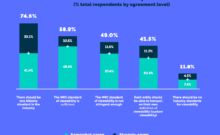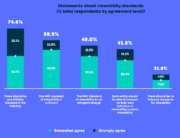You can’t open an advertising publication without hitting a dozen bylines about the ways in which digital is creating new opportunities for marketers. They’re not wrong, of course. Digital opens the door to greater scale, more accurate targeting and massive audiences at comparatively affordable prices. What these thought leaders often overlook is the ways in which digital also creates new problems for marketers. Compared to traditional media, digital marketing is always starting below zero.
No TV buyer has ever had to worry about whether their ad will be fully in view when it airs. When was the last time a print buyer was afraid that an ad placement in a glossy fashion magazine would run next to extremist content depicting an ISIS beheading? Newspapers have seen a subscription bump in the last 18 months and, to my knowledge, none of those subscribers reading the Sunday edition on their doorstep are bots.
Famed turn-of-the-century marketer John Wanamaker once said, “Half the money I spend on advertising is wasted; the trouble is, I don’t know which half.” In traditional media, it was safe to assume that every impression has, at least, the chance to count. For digital marketers, the prevalence of unviewable inventory, unsafe content and fraudulent impressions means that a percentage of their marketing dollars never have a chance to make their mark. They’re wasted on placements that are never seen, stolen by bot operating fraudsters, or worse of all, burned on unsafe content that harms the brand. But digital doesn’t have to start out in negative value. New technology is bringing digital advertisers back to solid ground and then helping them build on it.
If an ad can’t be seen, it can’t make a difference
Third-party verification is the first rung on the ladder that will help digital advertisers climb out of the hole of negative value and into the light. Measurement and verification technology has enabled advertisers to cut negative value from their advertising spend by identifying fraudulent, unsafe and non-viewable inventory and empowering marketers to exclude it from their campaign buys.
Read More At The Original Article: www.adweek.com









